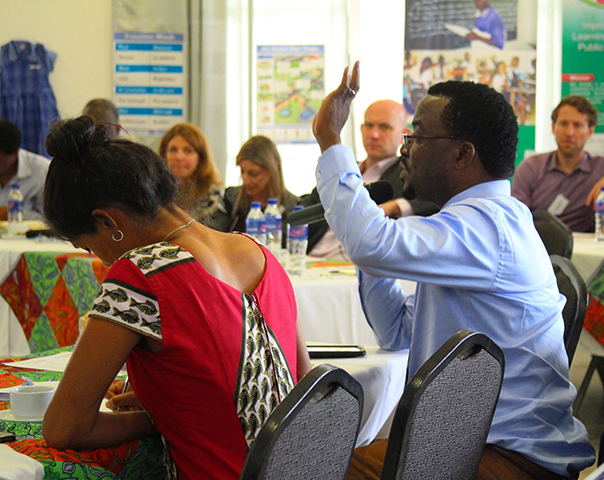Embedding Interventions Within Government Systems Works Well as a Starting Point, Not the Last Step
Welcome to Part 3 of our scaling lessons series (Part 1 here, Part 2 here). We've covered why scaling and systems change go hand-in-hand, and how misaligned incentives undermine cost-effectiveness.
This post covers a critical lesson that many organizations—including IPA in our earlier years—learn the hard way: when you engage government determines whether your intervention will scale successfully.
What we got wrong: Develop first, convince government later
As Co-Impact puts it, when we're tackling poverty at scale, we need solutions that match the size of the challenge—not the size of our organizations. For system-level problems, that often means working with the government as the implementer that can reach millions of people.
But here's what we've learned: if government implementation is our end goal, it should also be our starting point. The path to sustainable, large-scale impact runs through government systems from day one, not as an afterthought.
The common mistake: Develop first, convince later
Most organizations follow a seemingly logical approach: develop a promising intervention, prove it works through rigorous testing, then try to convince the government to adopt it later.
This approach faces predictable obstacles. Governments have their own priorities and constraints. They're dealing with packed agendas and competing demands for attention and resources. There's also a credit problem: government officials know they're unlikely to get recognition for scaling up someone else's intervention. Why would they prioritize implementing our solution when they could focus on initiatives they can truly call their own?
Why creating parallel systems isn't the answer
Faced with these barriers, many well-meaning organizations choose to innovate and scale outside of government systems entirely. They create what we call "parallel structures:" separate service delivery networks that operate alongside (but independent from) existing government systems.
Such well-meaning organizations may also be cautious about working with the government due to hesitation about working with suboptimal public systems. The difficulties in working through the public sector can seem to justify the “parallel systems” approach.
Unfortunately, these parallel structures have many limitations, including:
- Fragmented service delivery across regions and countries
- Coordination issues when multiple parallel systems operate in the same space
- Weakened government capacity as resources and expertise flow to external organizations
- Dependency on external funding that makes long-term sustainability uncertain
Parallel structures rarely address the whole size or the root cause of the problems they seek to address. Because they run parallel to existing systems rather than working to change them, they can't achieve either the scale or the system-level transformation needed to match the problem.
And even though working through the government to incubate a new program comes with real challenges, such challenges don’t go away when an intervention reaches the scaling stage. If the system isn't improved and the intervention isn't designed to handle these limitations from the start, then scaling—and impact—will ultimately fail.
The solution: Co-create with government from the beginning
As we dug deeper into our policy work, we started seeing more success with interventions that were co-created and incubated within government from the very beginning.
For instance, a video intervention in Peru, developed together with researchers Christopher Neilson, Francisco Gallego, and Oswaldo Molina alongside Peruvian policymakers and educators. The goal was simple: inform students about the returns to education through short engaging videos. The key difference was how we approached it. Instead of developing the intervention separately and then proposing it to the Ministry of Education, we co-designed it with the Ministry as an active partner, with them providing input and staying engaged throughout the process. They scaled it twice—once in 2018 and again in 2021, during COVID. Scaling happened even after staff turnover at the Ministry, because the history of co-ownership outlasted individual personnel changes and eased the path to scale.
In Ghana, we’re supporting the Ghana Health Service to scale an information campaign to encourage new and expectant mothers to have more conversations with their infants- a simple intervention that can significantly impact early childhood development. From the start, this campaign was designed to work within the Ghana Health Service's existing structure. Rather than creating parallel systems, its scale-up leverages the government's established network: national trainers, regional Trainers of Trainers, and district Health Promotion Officers who already implement health campaigns across the country. Even new materials are distributed through existing channels—for instance, the maternal health booklet that's already provided to all expectant mothers nationwide is being updated to include campaign content. This approach means no new infrastructure, no parallel systems, and no competition with existing government programs.
The teacher pay-for-performance (P4P) intervention in Rwanda exemplifies what full government ownership looks like. The program was incubated with the Rwandan government from the beginning, aligned with their existing policy of imihigo—performance-based bonuses for public servants that are deeply embedded in Rwandan governance culture. P4P isn't marketed as a separate intervention that the government might choose to adopt. It's not NGO-led. It is, quite literally, the way the government contracts public school teachers. This has made it a longer process to bring to scale, but it's also resulted in something genuinely government-led and owned. There's no question about sustainability or political commitment because the intervention is government policy.
Start with government priorities, co-create an expanded vision
We’ve learned to begin every potential government partnership by asking: What are the government's priorities? What challenges are they trying to solve? Most importantly, what solutions do they see as realistic options?
Policymakers understand their own constraints—political, financial, and operational. The solutions they're considering usually fit within those constraints, even if they seem limited to outside observers. Our role isn't to override those constraints or convince officials they're wrong about what’s possible. Instead, we begin with the options they're already considering and gently expand what they see as feasible.
This approach handles system constraints more effectively because it works within them from the start, rather than trying to overcome them later. It also ensures that interventions are designed with real-world implementation challenges in mind, making them more likely to succeed when they do scale.











